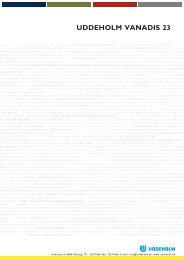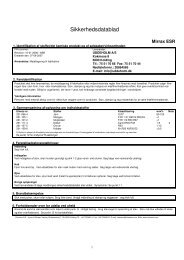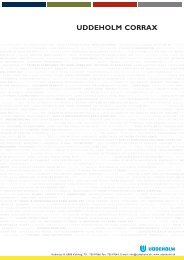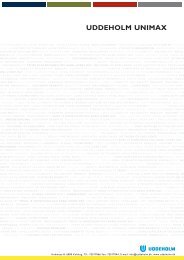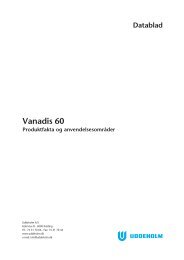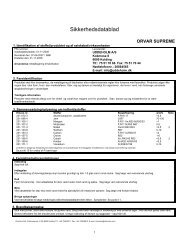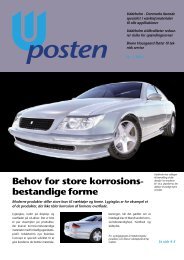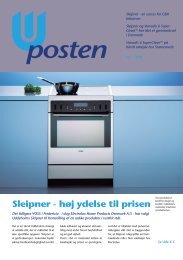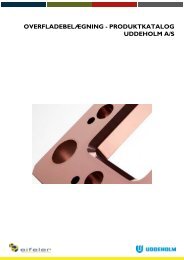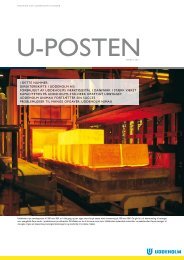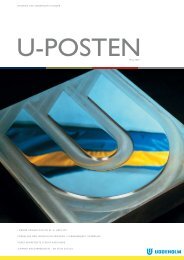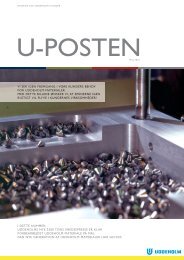You also want an ePaper? Increase the reach of your titles
YUMPU automatically turns print PDFs into web optimized ePapers that Google loves.
Datablad<br />
<strong>Formax</strong><br />
Produktfakta og anvendelsesområder<br />
<strong>Uddeholm</strong> A/S<br />
Kokmose 8 · 6000 Kolding<br />
Tlf.: 75 51 70 66 · Fax: 75 51 70 44<br />
www.uddeholm.dk<br />
e-mail: info@uddeholm.dk
FORMAX<br />
General<br />
FORMAX is a low carbon steel which can be<br />
supplied in as-hot-rolled or fine-machined condition.<br />
FORMAX is characterized by:<br />
• Good machinability<br />
• Easy to flame-cut<br />
• Good mechanical strength<br />
• Can be case hardened<br />
• Good weldability.<br />
Typical analysis % C Si Mn<br />
0,18 0,3 1,4<br />
Standard specification (W.-Nr. 10050, SS 2172)<br />
Delivery condition Hot rolled.<br />
Hardness approx.170 HB<br />
Colour code<br />
Black<br />
Applications<br />
• Bolsters<br />
• Punch holders<br />
• Die holders<br />
• Backing plates<br />
• Guide plates<br />
• Support plates<br />
• Jigs<br />
• Fixtures<br />
• Constructional parts.<br />
Properties<br />
TENSILE STRENGTH<br />
Approximate values at room temperature.<br />
Hardness 170 HB.<br />
Tensile strength Rm N/mm 2 560<br />
ksi 80<br />
Yield strength Rp0,2 N/mm 2 320<br />
ksi 45<br />
Reduction of area Z % 40<br />
Elongation A 5<br />
% 20<br />
Heat treatment<br />
recommendations<br />
FORMAX is intended for use in the as-delivered<br />
condition, i.e. not heat treated.<br />
For applications where the material must be hardened<br />
to a higher hardness, the following instructions<br />
should be followed;<br />
STRESS RELIEVING<br />
Temperature approx. 550–650°C (1020–1200°F).<br />
After rough machining with chip-cutting tools,<br />
stress relieving may be advisable to minimize<br />
distortion if the tool is to be hardened. Holding<br />
time: 2 hours after the entire piece has attained a<br />
temperature of approx. 650°C (1200°F). Cool in<br />
furnace to approx. 500°C (930°F), followed by<br />
cooling in air.<br />
CASE HARDENING<br />
The composition of FORMAX makes it highly<br />
suitable for case hardening. Case hardening can be<br />
carried out as follows:<br />
Carburizing temperature 850 –920°C(1560–1690°F).<br />
The time and temperature must be adapted to the<br />
required depth of hardening. Quench in salt water<br />
from 800–820°C (1470–1510°F).<br />
The following chart shows the rough relationship<br />
between the carburizing time and the depth of case at<br />
900°C (1650°F).<br />
Depth of case hardening, mm<br />
2,5<br />
2,0<br />
1,5<br />
1,0<br />
0,5<br />
0<br />
0 5 10 15 20 25 h<br />
Carburizing time<br />
TEMPERING<br />
Tempering at 200°C (390°F) gives a surface hardness<br />
of approx. 60 HRC.<br />
FLAME HARDENING<br />
FORMAX can be flame/induction hardened to<br />
40 ±3 HRC. Cooling in water. Case depth 1–2 mm.<br />
Temper immediately after hardening.<br />
3
FORMAX<br />
Cutting data<br />
recommendations<br />
The cutting data below are to be considered as<br />
guiding values which must be adapted to existing<br />
local condition.<br />
TURNING<br />
Turning with<br />
Turning<br />
carbide<br />
with high<br />
Cutting data<br />
speed steel<br />
parameters Rough turning Fine turning Fine turning<br />
Cutting<br />
speed (v c )<br />
m/min 200–300<br />
300–350 50<br />
f.p.m. 665–1000 1000–1165 165<br />
Feed (f)<br />
mm/r 0,3–0,6<br />
–0,3 –0,3<br />
i.p.r. 0,01–0,024 –0,01 –0,01<br />
Depth<br />
of cut (a p )<br />
mm 2–6<br />
–2 –2<br />
inch 0,08–0,24<br />
–0,08 –0,08<br />
Carbide<br />
designation<br />
ISO P20–P30 P10 —<br />
Coated carbide Coated carbide<br />
or cermet<br />
End milling<br />
Type of of milling<br />
Carbide<br />
Cutting data Solid indexable High<br />
parameters carbide insert speed steel<br />
Cutting<br />
speed (v c )<br />
m/min 80 150–200 45 1)<br />
f.p.m. 265 500–665 150 1)<br />
Feed (f z )<br />
mm/tooth 0,03–0,20 2) 0,08–0,20 2) 0,05–0,35 2)<br />
inch/tooth 0,001–0,008 2) 0,003–0,008 2) 0,002–0,014 2)<br />
Carbide<br />
designation<br />
ISO K20 P20–P40 —<br />
1)<br />
For coated HSS end mill v c ~60 m/min. (200 f.p.m.).<br />
2)<br />
Depending on radial depth of cut and cutter diameter.<br />
DRILLING<br />
High speed steel twist drill<br />
Drill diameter Cutting Feed (f)<br />
speed (v c )<br />
mm inch m/min f.p.m. mm/r i.p.r.<br />
– 5 –3/16 25* 100* 0,08–0,20 0,003–0,008<br />
5–10 3/16–3/8 25* 100* 0,20–0,30 0,008–0,012<br />
10–15 3/8–5/8 25* 100* 0,30–0,35 0,012–0,014<br />
15–20 5/8–3/4 25* 100* 0,35–0,40 0,014–0,016<br />
1)<br />
For coated HSS drill v c ~40 m/min. (135 f.p.m.).<br />
MILLING<br />
Face- and square shoulder milling<br />
Milling with<br />
Milling<br />
carbide<br />
with high<br />
Cutting data<br />
speed steel<br />
parameters Rough milling Fine milling Fine milling<br />
Cutting<br />
speed (v c )<br />
m/min 200–275 275–375 45<br />
f.p.m. 665–915 915–1250 150<br />
Feed (f z )<br />
mm/tooth 0,2–0,4 0,1–0,2 0,1<br />
inch/tooth 0,008–0,016 0,004–0,008 0,004<br />
Depth<br />
of cut (a p )<br />
mm 2–5 –2 –2<br />
inch 0,08–0,20 –0,08 –0,08<br />
Carbide<br />
designation<br />
ISO P20–P40 P10–P20 —<br />
Coated Coated<br />
carbide carbide or<br />
cermet<br />
Carbide drill<br />
Type of drill<br />
Cutting data Indexable Solid Brazed<br />
parameters insert carbide carbide 1)<br />
Cutting<br />
speed (v c )<br />
m/min 200–250 90 80<br />
f.p.m. 665–830 300 265<br />
Feed (f)<br />
mm/r 0,05–0,25 2) 0,10–0,25 2) 0,15–0,25 2)<br />
i.p.r. 0,002–0,01 2) 0,004–0,01 2) 0,006–0,01 2)<br />
1)<br />
Drill with internal cooling channels and brazed carbide<br />
tip.<br />
2)<br />
Depending on drill diameter.<br />
GRINDING<br />
A general grinding wheel recommendation is<br />
given below. More information can be found in the<br />
<strong>Uddeholm</strong> publication “Grinding of Tool Steel”.<br />
Wheel recommendation<br />
Soft annealed Hardened<br />
Type of grinding condition condition<br />
Face grinding<br />
straight wheel A 46 HV A 46 GV<br />
Face grinding<br />
segments A 24 GV A 36 GV<br />
Cylindrical grinding A 46 LV A 60 JV<br />
Internal grinding A 46 JV A 60 IV<br />
Profile grinding A 100 LV A 120 JV<br />
4
FORMAX<br />
Flame-cutting<br />
FORMAX is suitable for flame-cutting. Normally,<br />
no tempering of the cutting edge is needed before<br />
machining, since the machinability is not affected.<br />
Welding<br />
FORMAX has extremely good weldability and<br />
normally it needs no heat treatment in connection<br />
with the welding operation. However, if there is a<br />
risk of an abnormally high cooling rate, holding at<br />
100–200°C (210–390°F) is recommended. Stress<br />
relieving, if any, is carried out at 550–600°C (1020–<br />
1200°F).<br />
The low carbon content reduces hardness variations<br />
in the material after welding to a minimum.<br />
Further information<br />
Please, contact your local <strong>Uddeholm</strong> office for<br />
further information on the selection, heat treatment,<br />
application and availability of <strong>Uddeholm</strong> tool<br />
steels.<br />
Gas cutting of FORMAX can be made by Hagfors<br />
Mekaniska Verkstad, (HMV), which is a company<br />
owned by <strong>Uddeholm</strong> Tooling.<br />
5



